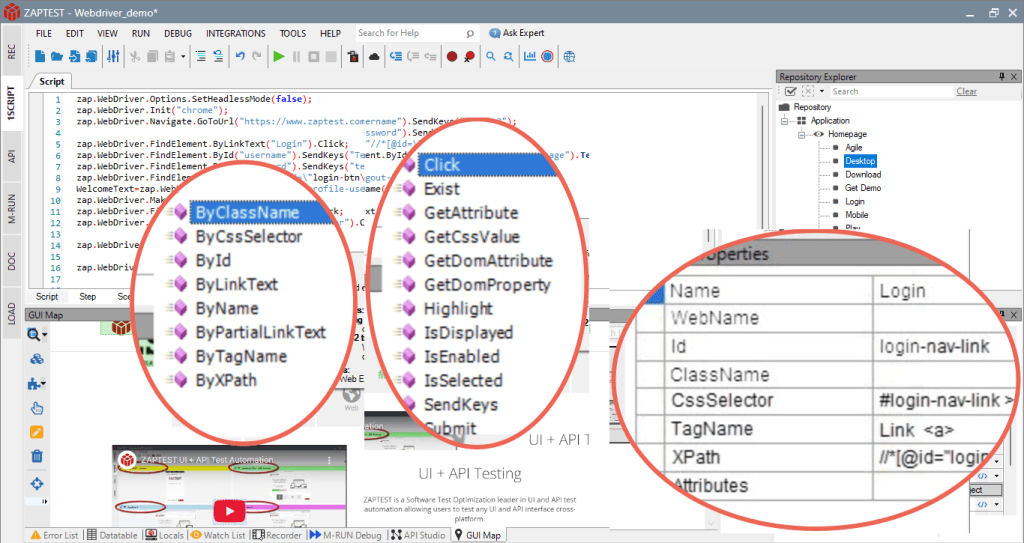Software quality assurance is a process that helps development teams ensure the quality of their software before it is released. While QA and testing have many similarities, Quality Control (QC) and software testing can be seen as subsets of Quality Assurance.
In this article, we’ll explain what QA testing is, how it relates to other types of software testing, explore the different testing types in QA, and recommend the best tools for the job.
What is QA testing?
Quality Assurance is a critical part of the software development life cycle (SDLC). It aims to ensure the software application functions as well as possible through the use of various activities, like planning and designing test strategies, all the way to conducting tests, evaluating the results, and reporting and resolving defects.
Delivering products on time and on budget is very important. But it doesn’t count for much if the quality is not there. This situation gets to the heart of QA. It’s an approach that is focused on ensuring that stakeholders are satisfied with the final product in terms of functionality, specifications, and user experience.
Objectives of QA testing
Software quality assurance has several objectives. At a high level, it’s about ensuring that an application meets customer requirements and any outlined specifications. But what does that mean in a more concrete sense?
Let’s dig in further by exploring the many objectives of software quality and assurance.
#1. Identify and resolve bugs and defects
Software bugs, defects, errors, and glitches compromise both the user experience and the overall functionality of a given piece of software. QA testing aims to both uncover these issues and ensure they are resolved.
Catching bugs and defects early in the SDLC means that developers can fix problems while they are manageable.
#2. Requirement conformance
Each piece of software is built to solve a problem or pain point. During initial development, various features and functions are proposed to suit the needs of a target audience. QA testing ensures that these needs and specifications are met so that the software solves the issues it was built to address.
#3. Improved User Experience (UX)
User Experience (UX) has become a huge consideration over the last decade or more. Competition between software developers is stiff, so ensuring that an application is user-friendly, intuitive, and accessible is a commercial imperative. QA testing looks at navigation, user interactions, error handling, and more to ensure the application’s target market feels happy that the software can solve their pain points or requirements.
#4. Validate stability
Even a well-designed piece of software can be undone by stability issues. Crashes, freezes, unexpected behaviors, and more frustrate the user and undermine their confidence in an application. QA testing seeks to understand how the software performs under different conditions or scenarios before it is released into the wild.
#5. Ensure compatibility
Modern software needs to be compatible with different operating systems, browsers, devices, and hardware configurations. Failure to test for these eventualities can seriously hinder the reach of your software and its financial potential. QA helps ensure your solution runs in different environments.
#6. Maintain competitiveness
With so many potential solutions out there, users are spoiled with choices. Indeed, in many software niches, competing with rivals is a matter of increasingly fine margins. Ensuring that your software is usable and stable is crucial for meeting user expectations and ensuring that you are positioned well against your competition.
#7. Leverage test results
QA testing helps teams generate and analyze the data needed to improve software builds. Comprehensive test results provide powerful insights into a software’s quality and ensure problems are resolved quickly and efficiently. What’s more, this documentation helps management, investors, and other stakeholders stay up to date on development.
#8. Build customer and stakeholder trust
Trust is an important factor in ensuring customer satisfaction and retention. A company that develops a reputation for high-quality, reliable software can stand out from its peers and foster a culture of excellence.
#9. Mitigate risks
Quality assurance is about more than stable builds. It can also protect you against the various risks involved with developing software. These hazards can range from reputational damage that results from poor or bug-ridden releases to legal or financial damage that results from inadequate builds.
#10. Data-driven decision making
QA testing gives managers the raw materials they need to make data-driven decisions to improve their software. The right data can help teams understand which tasks should be prioritized, how to optimize their resources, and even help understand and assess risks, all based on the results of rigorous testing.
What is a quality assurance strategy?
A Quality Assurance strategy is an integral part of the SDLC. It is a plan that details the relevant processes and procedures required for high-quality software projects. A solid QA strategy plan should make clear what is required at each stage of the SDLC.
Let’s take a look at the key components of a QA strategy.
1. What should a QA strategy contain?
A solid QA strategy requires a few different components. Here are the essentials.
Mission statement
A QA strategy should start with a clear mission statement that outlines the goals and objectives of the strategy. This is an important part of the process because it sets the standards for quality and helps ensure that your team is gathered around shared objectives.
Acceptance criteria
To ensure that everyone is working towards a shared vision, a QA strategy should outline clear and measurable criteria for accepting a piece of software as being complete. Setting these measures must take into account several factors, including requirements, user needs, and overall business objectives.
Testing approaches
These documents should also outline the tools and testing methodologies incorporated during the SDLC. You should list both manual and automated testing tools and methods alongside the techniques and frameworks in use during testing.
Employee roles
The QA strategy should also explore the staff and roles involved in quality assurance and make clear the skills and responsibilities that are required to meet the needs of a modern and comprehensive testing approach.
Defeat management process
A QA strategy should also outline team policies for reporting, tracking, and resolving defects. This section should also enshrine escalation procedures involved with defects, bugs, and other issues that occur during testing.
Feedback
A solid QA strategy must also highlight how feedback is delivered to and incorporated by developers. In particular, the strategy should help formalize the process to ensure swift resolution of issues.
CI/CD
Finally, a QA strategy should be implemented into a Continuous Integration/Continuous Delivery (CI/CD) pipeline to allow for software testing automation that tests code before deployment.
Benefits of QA testing
Software quality assurance has many benefits. Here are a few of the most important advantages for development teams.
#1. Improved product quality
One of the biggest benefits of QA testing is that it facilitates a proactive approach to finding and resolving bugs and defects. Unearthing these errors during development rather than in production saves rework and delays and reduces customer dissatisfaction.
#2. Lower development costs
Investing in good QA testing can bring about an excellent ROI because early detection and resolution of bugs and defects are much less cost-effective than finding them later in the SDLC.
#3. Boost productivity
Again, by detecting problems as early as possible, the entire SDLC becomes more efficient. Reducing delays and disruptions helps streamline the development process, resulting in quicker releases without compromising on quality.
#4. Better security
Security is a big focus in QA testing. A solid security testing program helps find and resolve vulnerabilities. With the advent of GDPR and other data-focused regulations, protecting customer data has become an existential risk for developers.
#5. Industry-standard compliance
Many industries, such as healthcare, banking, and insurance, have strict standards and regulations for software. Testing assures that software meets these requirements.
#6. Detecting technical debt
With so much pressure to release software on the market, many teams take shortcuts or compromises to ensure they meet milestones. However, this can result in reworks or increased maintenance costs, also known as technical debt. QA testing can help catch and resolve technical debt before it grows and accelerates maintenance costs.
What are the challenges involved in QA testing?
The fantastic benefits of QA testing listed above underline the importance of this discipline. However, there are challenges to taking this approach. We can broadly split these challenges into three categories which are technical, organizational, and individual. Then, we will propose some solutions to these issues.
Technical
1. Incomplete or unclear requirements
Poorly communicated or inadequate requirements are common issues in software development. A requirements specification document (RSD) is a vital component of any product. It acts as a blueprint that outlines the needs and expectations for a product. However, too often, poor requirement gathering means that inputs to these documents are misleading and can result in inadequate testing coverage or missed bugs.
2. Resource limitations
Tight development budgets can force product managers to cut corners. Whether it’s a lack of staffing, specialist testing staff, or an underinvestment in quality assurance automation software tools, limited resources can hurt the quality of the final product. What’s more, if you pile excessive pressure on your limited resources, it can have other adverse effects, such as exhaustion or burnout. These scenarios can lead to low morale or delays.
3. Inadequate testing environments
A solid testing environment is critical for good QA testing. However, many teams lack the foresight to give the QA analysts the right tools for the job. Some situations that can hinder high-quality QA testing include old or outdated hardware, buggy or unreliable testing frameworks, and even network problems.
Any of these issues can cause huge frustrations for testers and result in delays for the project.
4. A quality assurance automation testing expertise deficiency
QA automation testing is a superb way to slash the resources required for comprehensive testing. However, too many teams struggle to implement these time-saving tools because they lack access to proper automation expertise. While many QA automation tools are user-friendly, setting up and maintaining tests can prove complicated for untrained staff.
5. Staying up-to-date with technology
The technological landscape moves quickly. Testers need to stay current on cutting-edge tools and methodologies to ensure their QA testing is sharp and efficient. However, evaluating and understanding new technology takes time and effort. Additionally, adopting these products requires investments that go beyond existing budgets.
Organizational challenges
1. Tight deadlines
Software developers are under immense pressure to meet tight deadlines. Some deadlines are well-considered and reasonable; others are completely unrealistic. There are several reasons for this, ranging from commercial pressures to unfamiliarity with the testing processes and, in some cases, plain old wishful thinking.
The big problem here is that excessively tight or unrealistic deadlines can result in corner-cutting or hasty tests, which will ultimately compromise the quality of the software.
2. Changing requirements
Shifting requirements, especially at late stages of development, are catastrophic for quality assurance. When these citations occur, testers need to adjust and adapt on the fly, testing needs to be redone, and previously agreed timelines must be redrawn. None of these situations is desirable.
3. Poor management
QA software engineering testing is about striking a balance between quality and speed. Achieving an acceptable level in both criteria requires solid management and delegation. Unfortunately, not all product managers are up to the task, which can lead to costly delays, poorly built software, or both.
4. Ineffective collaboration
Great quality assurance testing requires solid collaboration between developers and testers. Sadly, many teams are lacking in this department. Some common issues are down to a lack of understanding of just how much time and effort is required to meet acceptable testing standards. Teams that exist in silos or bubbles can easily miss out on bugs or lack a full understanding of the software.
5. Bad communication
A lack of communication between testers, developers, and stakeholders can have disastrous consequences. When teams don’t know how to communicate effectively, it can lead to ambiguity in testing and communicating specifications. The downstream consequences are misunderstandings, reworks, and the perils of shifting requirements.
Individual challenges
1. Objectivity
Maintaining objectivity, especially when testing work done by your own colleagues, can be difficult. Even if this favoritism happens on a subconscious level, it can lead to bugs and defects going unchecked.
2. Testing bias
Testers are human. As such, they are subject to cognitive biases in the same way as any other worker. These biases can emerge in any part of the STLC, from the design of test cases to how the results of tests are analyzed and interpreted. What’s more, some testers can favor certain perspectives during the testing process, which leads them to ignore other key issues.
3. Repetition
Finally, software testing is full of repetitive and mundane tasks. When testers repeat tasks over and over, they can lose some of the joy they have for the job. This situation can lead to increased human error, dissatisfaction, and burnout.
How do we solve the challenges of QA testing?
The problems listed above are major barriers to achieving software quality engineering. Thankfully, you can overcome these issues with a mix of strategies.
1. Clear and concise communication
The collaborative nature of QA testing means that communication between testers, engineers, and stakeholders is something you must take seriously. Establishing open lines of communication and ensuring any documentation is clear and easy to understand can go a long way toward removing ambiguity and confusion from the QA testing process.
2. Establish feedback loops
Establishing feedback loops between developers and testers can help bring new levels of accuracy and efficiency into your code. When engineers know where problems are arising, they can absorb this feedback into their work. Indeed, close collaboration between all parties promotes knowledge sharing and helps identify issues early and iterate more quickly.
3. Learning and development
Carving out time for engineers and your QA testing team to learn and develop is essential to retaining and retraining top talent. When developers add new skills to their toolbox, it leads to better software builds. What’s more, if you encourage them to embrace and adopt new technologies and methodologies, they will keep your testing up-to-date and relevant.
4. Invest in automation tools
While manual and exploratory testing is still important for comprehensive QA, investing in test automation tools saves time and money and relieves your testers from mundane and repetitive tasks. Test automation tools, like ZAPTEST, are hugely sophisticated, robust, and varied.
Moreover, ZAPTEST Enterprise clients get access to a full-time, dedicated ZAP Expert. This addition helps teams cross the automation skills gap because they have someone who can help implement and deploy ZAPTEST tools across the workplace, ensuring cutting-edge software and QA testing.
What is the difference between QA and testing?
Quality Assurance (QA) and Testing are two terms that are frequently used interchangeably within software development circles. However, they describe different things. Indeed, understanding the difference between QA and testing is important for your projects.
To explore the concepts fully, we need to think about three distinct entities. They are:
- Quality Assurance
- Quality Control
- Testing
1. Quality Assurance (QA)
Quality Assurance is a broad concept that is concerned with guaranteeing that the right policies and procedures are followed to ensure a high-quality software build. It is a proactive process that is just as concerned with preventing bugs as it is with identifying and resolving them.
A huge part of achieving quality assurance within software development involves the presence of a QA strategy (outlined in detail above).
2. Quality Control (QC)
Quality Control is a related but distinct phase of Quality Assurance. While QA deals with the entire SDLC, Quality Control is about verifying the latter state of the project when it is close to a finished project. QC is concerned with the correct and faithful implementation of the overall QA strategy.
QC is also notable for its focus on the end user. It helps ensure that user experience is strong by understanding and meeting user requirements and specifications. Where QA is proactive, QC is reactive. Overall, the idea here is that QC is done before the product gets to the users and includes things like product walkthroughs, testing, inspections, code reviews, and so on.
3. Testing
As shown above, software testing is part of implementing Quality Control. It involves understanding project specifications and customer requirements, testing the product against these standards, and finding any bugs and defects. There are several different types of tests that can occur, and implementing them involves a fairly extensive process of drawing up a test plan, designing test cases, and reporting and resolving defects.
As laid out above, these three distinct approaches work in harmony to achieve Quality Assurance. While they are different, they are motivated by the same objective: delivering a solid product that the company can stand behind.
10 Different types of QA testing
There are many quality assurance types of testing that you need to know. Here is a list of 10 software QA testing types that will cover most of the eventualities you need to consider on the path to building robust software that meets user expectations.
#1. Unit testing
Unit testing is a basic testing type that isolates and tests individual units of code. In general, unit testing starts during the early stage of software development, with the idea being that smaller components and methods or even single lines of code are verified before pressing on with other works.
Breaking down an application into small, manageable chunks helps product teams understand the overall functionality of their code and understand how changes can affect related parts.
#2. Component testing
While Unit testing is focused on units of code, component testing focuses on components, or as they are also called, modules. Indeed, this testing type is also referred to as Module testing. A component testing approach involves testing multiple units at one time.
Component testing is concerned with the functional aspects of each unit, but it also attempts to verify how components integrate with each other. Testing these interrelations can help teams discover defects early in the process and remedy issues by isolating the problematic components.
#3. Integration testing
Integration testing is the logical next step after Unit and Component testing. It seeks to verify how modules or components function together as part of a unified system. Integration combines components into their related groups and verifies if they meet function requirements.
#4. End-to-end testing
End-to-end (E2E) testing verifies the functionality and performance of an entire software application from start to finish — or end-to-end. The idea here is to establish how a product will perform within a live environment. This type of testing simulates real-world use cases and live data to get a thorough idea of the flow of data and information through the application, from input to output.
#5. Performance testing
Performance testing is a proven way of testing how an application functions when placed under duress or heavy usage. Some of the things it tests are a product’s speed, stability, responsiveness, and resource allocation.
Common types of performance testing include:
- Load testing: This testing type simulates excessive amounts of transactions or users to see how the software handles extra load
- Stress testing: Identifying potential bottlenecks or failures by pushing the application beyond its limits
- Volume testing: This type of testing uses large volumes of data or concurrent users to see how the application performs
- Endurance testing: This type of testing tries to ascertain how an application will operate when given a constant load for an extended period of time.
#6. Regression testing
Regression testing involves re-running previously administered tests to see how changes or modifications to the software have affected functionality. It’s a hugely important part of ensuring application stability and quality because it can help highlight the unintended consequences of updates. By reusing previously accepted tests, testers can quickly highlight where issues have occurred, leading to a swift resolution.
#7. Sanity testing
While lacking the comprehensiveness of Regression testing, Sanity testing is a quick and useful way to find bugs or critical failures after integrations, repairs, or bug fixes. Sanity testing can be seen as a trade-off between speed and the thorough nature of Regression testing.
There are two main types of sanity testing: White-box sanity testing and Black-box sanity testing.
- White-box sanity testing is a general type of software testing that involves tests with access to the application source code. Access to the source code means they can find areas of code that are likely candidates for issues and focus their testing on these parts.
- Black-box sanity testing involves testers without access to source code. They instead focus on the functionality of the software and explore areas that are logical candidates for defects.
#8. System testing
System testing looks to test the application at a system level. This kind of testing evaluates the entirety of the software system against its requirements and functionality. System testing happens after individual modules and components have been put through their paces. In effect, it’s about understanding how a fully integrated version of the software works all together.
#9. Smoke testing
Smoke testing is a type of sanity testing that looks for severe issues in a new software build. Again, like the other types of sanity tests we’ve listed above, it’s more about verifying basic functionalities rather than a thorough drive through an exhaustive list of features.
Smoke testing, also frequently referred to as Confidence testing or Build Verification Testing (BVT), comes in two forms: manual and automated.
- Manual smoke testing is the traditional approach where testers carry out manual smoke tests
- Automated smoke testing is an increasingly popular approach where test cases are executed automatically, saving both time and money.
#10. User acceptance testing
User acceptance testing (UAT) is one of the testing types in the QA lifecycle. Typically, it’s carried out just before the software is released to the end user. This testing type involves sending a finalized product to real end-users to test if it fulfills specifications and expectations. UAT can involve users, customers, or stakeholders, and the process is known for its ability to detect defects and reduce maintenance costs.
While this list of the 10 best quality assurance types of testing approaches covers all the bases, it’s important to remember that there are other testing methods that are appropriate for different situations. The choice comes down to the specifications of each piece of software.
Quality assurance organizational methods
that you need to know
While the end of quality assurance testing is to have the best product possible, there are a number of approaches and philosophies. Here are a few different quality assurance methods that are used by organizations and product managers across the world.
1. Total Quality Management (TQM)
Total Quality Management (TQM) is a software development philosophy that creates a culture of excellence by focusing on:
- Customer satisfaction
- Employee engagement
- Process improvement
TQM is focused on typical QA goals like finding and resolving defects. However, it’s more holistic in scope and also aims to build a culture where all team members are invested in building strong workflows and processes geared towards the best software builds.
Key tenets on TQM
- Customer-centric: TQM is focused on going above and beyond for customers. That means taking the time to really understand what customers want and developing software that solves their pain points.
- Employee involvement: TQM involves everyone in development, not just engineers and testers.
- Continuous improvement: Another important aspect of TQM is always looking for new tools, methods, and processes to improve software.
- Process focus: TQM is heavily focused on building solid, well-tested processes such as Agile methodologies like Scrum and Kanban.
2. Process and Product Quality Assurance (PPQA)
Process and product quality assurance (PPQA) is a well-rounded approach to ensuring quality software products. Instead of just testing the final product, PPQA emphasizes the entire product development life cycle.
PPQA follows many of the best practices of QA by taking a holistic approach to product delivery. This method includes:
- Developing extensive documentation for development standards
- Performing audits for all software development processes to outline and remedy potential weaknesses, bottlenecks, and inefficiencies
- Comprehensive learning and development for engineers
- Using data and feedback to improve the development process continuously.
3. Failure testing
Failure testing, commonly referred to as negative testing, is a quality assurance technique that seeks to break the program by providing invalid inputs, unexpected conditions, edge cases, and more. The aim of these methods is to uncover bugs and defects before the software is released.
Software QA testing types in failure testing
Here are some common types of failure testing:
- Equivalence partitioning: This testing technique involves diving inputs into equivalence classes. Then, it tests only one input from each class, theoretically cutting down on testing time.
- Boundary testing: The testing involves giving the software inputs that are outside its expected range of values
- Error guessing: Engineers guess which errors may cause issues with the software and build test cases to explore these potential defects
4. Key tenets of failure testing
Some of the core tenets of failure testing include the following:
- Think like a hacker: Failure testing encourages testers to think like someone who was trying to break or expose the vulnerabilities of a piece of software. By overloading the system or attempting to inject the software with malicious code, developers can understand more about their product’s potential weaknesses.
- Go beyond the expected behavior: Many test cases verify the software against the expected behavior. Failure testing takes more unconventional paths to discover edge cases.
- Break things: Failure testing encourages testers to break the software early in development. These fractures will only make the end product software once they are repaired.
Of course, these are just some of the methods used in software quality engineering circles to ensure a solid development culture.
Different software and QA methodologies
Depending on the scope of the project, organizational preferences, and project restraints and requirements, different methods and frameworks are appropriate. Let’s look at the three best methods that are used within a QA testing approach.
#1. Waterfall method
The Waterfall method is a traditional software development approach. It is often said that it follows a “sequential, phase-gated approach” to developing software. In short, it takes its name from the waterfall because it describes water cascading from a height, with each stage beginning before the next proceeding.
In a development context, this means that requirement gathering must happen before design, then development, then testing, and so on.
While this approach is structured and disciplined, it lacks the flexibility and built-in collaboration of other methodologies. Most troubling is the method’s risk of late-stage defects that can be expensive and time-consuming to rectify.
#2. Agile methodology
While Agile methodologies and QA testing are distinct concepts, they have some relations and can work well together. Let’s explore them individually before seeing how they can be used in concert.
Agile methodologies
- Focus on delivering software in short bursts of 1-4 weeks, typically called sprints. This iterative approach is in stark contrast to the Waterfall method described above.
- Sprints give developers a chance to get feedback and insights and learn from mistakes. This approach opens the door to continuous improvement.
- Agile teams are typically cross-functional. As such, engineers, testers, stakeholders, and product owners work together in a more holistic approach to product development.
QA testing within Agile
- Continuous testing is a big part of Agile, with a high dependence on frequent, automated software tests across the development lifecycle. The approach helps teams keep an eye on defects and regressions that may be introduced due to new features or functions.
- Agile also supports shift-left testing, meaning that products are tested as early as possible in the development lifecycle. Again, the main benefit here is to find and resolve bugs and defeats as early as possible and while they’re easy to fix.
- A QA software engineering approach matches Agile’s emphasis on close collaboration between testers and developers. These feedback loops break down silos and ensure everyone is pulling towards the goals of quality software.
#3. DevOps
DevOps is an innovative approach to software development that combines the development and operations teams. When combined with QA testing, another silo is broken down by adding the QA team. With greater collaboration and shared ownership of the software development processes, teams can release better, quicker software.
Some of the main characteristics of a DevOps and QA approach include:
- Shift-led testing, similar to the Agile approach above
- Continuous Integration and Delivery (CI/CD) means that code is merged and tested several times a day, meaning feedback is implemented and regressions are fixed quickly
- DevOps heavily avails of software test automation for both software and QA testing, ensuring quicker, more cost-effective testing that frees up developers for more value-driven tasks.
- Continuous testing and improvement are another huge aspect of the DevOps approach that chimes with the quality assurance in software testing ideals.
As you can see, a quality assurance in software testing approach can use any of these methods. However, getting the full value from QA testing requires an Agile/DevOps approach.
Implementing a software quality and assurance strategy
A solid software quality test strategy requires careful and considered planning and informed choices on your test environment, test cases, and the software you use for the job. In this section, we’ll outline the best way to implement a QA test strategy.
#1. Evaluate your test environment
Your software test environment is instrumental to testing. It’s the venue where applications are tested and evaluated and includes things like:
- Hardware
- Software
- Network
- Test data
- Testing tools
Ensuring that your environment is up to scratch will go a long way toward achieving robust quality assurance testing.
Establishing an appropriate testing environment requires doing the research to understand your product’s:
- Features
- Specifications
- Dependencies
- Requirements
- Architecture
- Integrations
In the best-case scenario, all this information will be at your fingertips thanks to comprehensive documentation. Once you have gathered all this information, you’ll be able to understand if your test environment is capable of the kind of quality assurance testing required before shipping a release.
#2. Develop test cases
Once you are satisfied that you have a robust test environment, you need to build your test cases. Building test cases is a methodical process. Here are some steps to follow:
- Gather as much information as possible on user requirements, expectations, and specifications. Analyze features, functions, and edge cases
- Build a traceability matrix and map each product feature to designated test cases. Ensure you have full coverage for everything you need.
- If required, use test case templates to write out your tests
- Ensure your test cases are clear and concise and that there are quantifiable outcomes to evaluate acceptance
#3. Figure out what test data you need
With your test cases designed, it’s time to figure out which kinds of data you need to validate your software. Some data you may require includes:
- Valid and invalid data
- Representative data
- Boundary values
- Performance testing data
- Security testing data
Ensure you have all your data ready before testing and set up any accounts you might need to put your product through its paces.
#4. Select the best QA testing tool
Tight deadlines and strict budgets mean that software test automation tools are essential for businesses that want to compete. Choosing the right test automation tool is essential. ZAPTEST provides a robust suite of testing tools that allow teams to run concurrent testing, validate GUIs and APIs, and even run self-healing bots across multiple platforms and devices.
No-code testing tools, unlimited licenses, and RPA integration help ZAPTEST stand out from its rivals.
#5. Test & Analyze
Once you follow steps 1-4, it’s time to move on to performing software testing. With a solid testing schedule outlined, you should methodically work your way through your test cases. A solid test plan is essential here for ensuring coverage. When you get results, add them to your test plan and analyze the outcomes. Schedule fixes for bugs and defects to ensure the software meets stakeholder expectations.
#6. Repeat then release
Once your tests are run, and bugs and defects have been resolved, it’s time to repeat your tests to ensure quality assurance is achieved. Clear and objective outcomes in your test plan must be achieved. Finally, double-check you meet any industry requirements before signing off the product for release.
Which roles are involved in QA testing?
What does a robust QA testing team look like? Here is a quick rundown of the personnel required to perform solid software quality and assurance testing.
1. Software quality analyst
Software quality analysts test software and also help teams predict bugs and defects that could arise in the future based on their analysis.
2. QA automation engineer / QA tester
QA automation engineers and QA testers look to identify bugs and defects before they get to the customers.
3. Test architects
Test architects play a crucial role in QA testing by building and designing the tests used to validate the software properly.
4. QA lead
A QA lead is a team leader. They typically oversee testing and make sure schedules are adhered to.
5. QA Manager
QA Managers liaise between the QA team and customers. They deliver reports, work with analysts, and evaluate product quality to ensure it meets expectations.
What is the best software quality assurance software?
In the last few years, some excellent software quality assurance software has emerged on the market, providing quicker and more cost-effective avenues toward comprehensive testing. Let’s explore some of the best tools on the market.
1. Best all-in-one tool: ZAPTEST
ZAPTEST is an industry-leading test automation tool that comes packed with quality test automation tools. WebDriver Integration, Parallel Execution, No-code testing, Live testing, and Cross-Platform and Cross-Application testing are just some of the huge benefits of this software.
It’s the perfect tool for Agile/DevOps teams and comes with a dedicated ZAP Expert and Unlimited licenses. What’s more, it includes first-class RPA tools and innovative AI solutions like a coding CoPilot and Computer Vision Technology (CVT).
ZAPTEST helps meet all your software and QA needs thanks to its robust suite of capabilities. Furthermore, it’s user-friendly, intuitive, cost-effective, and the ideal choice for teams who are eager to embrace the futuristic world of hyperautomation.
Recommended tool for manual testing
TestRail is a solid test case management tool. The software helps QA teams organize testing and track results. Additionally, it allows teams to collaborate effectively, which is a core concept in QA testing. With excellent real-time reports and insights, scalability, and a user-friendly interface, it’s easy to see why it’s a good option for teams who use manual testing.
Recommended tool for automated testing
Selenium is a free, open-source software testing tool with automation capabilities. It supports lots of different web browsers and platforms and languages like Python, Java, JavaScript, C#, Ruby, and more. It’s flexible, allows for reusable tests, and has a strong user community, making it a good tool for QA testing.
Recommended tool for performance testing
New Relic is a good QA and automation tool for performance testing. Integrated load testing, root cause analysis, bottleneck detection, and excellent report tools make this a good choice for QA-focused performance testing.
While each recommended tool is great at its job, if you want a powerful all-in-one tool that excels at manual, automated, and performance testing, ZAPTEST should be your number one choice.
Software quality and assurance:
Manual or Automated?
Test automation tools have changed the world of software testing forever. With budgets and deadlines growing tighter than ever, automated testing has grown in popularity. However, is there still room at the table for manual testing?
1. The role of quality assurance manual testing
For most of the history of quality assurance in software testing, most processes were performed manually. The last decade or so has seen the rise of software automation tools, but manual testing still has utility when it comes to QA testing. Here are some of the areas where it can help:
- Exploratory testing
- User experience testing
- Confirmation testing
2. The benefits of quality assurance automation testing
Quality assurance automation has taken over in recent years due to speed, cost-effectiveness, convenience, and excellent testing coverage. QA and automation tools help detect defects early and improve both accuracy and consistency of the testing process. What’s more, they facilitate QA and testing approaches, like CI/CD, and help teams embrace Agile/DevOps methodologies.
QA and automation testing are both part of a modern approach to software development. While manual testing still has its place, test automation is slowly taking over and growing in quality, thanks to AI-assisted tools that can replicate user experience testing.
Software quality and assurance best practices
Quality Assurance is a complex field with lots of ins and outs. However, with the right preparation and awareness, it doesn’t have to be a chore. Here are some tips and best practices to ensure your software builds are as good as possible.
1. Using CI/CD
Continuous Integration and Continuous Delivery (CI/CD) testing is essential for quality assurance. Because developers update small sections of code into a centralized module, you can prioritize test automation on each new addition. You can detect bugs early and ensure any issues are resolved quickly and efficiently. Automated testing means you take advantage of consistent and standardized testing across the pipeline and ensure new features don’t break existing functionality, preventing regression.
2. Use a blend of manual and automated testing
There are so many benefits of software test automation, including reduced cost, more test coverage, saving time, reduced human error, and overall improvements to software quality. These advantages are so considerable that they can obscure the utility of manual testing.
Manual testing still has its place in Quality Assurance testing, especially when you need to find edge cases or situations that are relevant to user experience. So, while test automation has become so sophisticated that it can cover most eventualities, combine the power of both testing types if you have excess time and budget.
3. Keep your test cases clear and concise
Avoid writing test cases with too much jargon. While technical language is unavoidable in some scenarios, it’s best to keep things clear and concise. Any confusion or ambiguity in test cases can result in criteria being accepted or rejected incorrectly. So make sure your objectives and outcomes are easy for everyone to understand, and any steps you include are simple to replicate.
4. Communication is key
Quality Assurance involves stakeholders from all across the business. So, ensure that product managers, clients, developers, and any other relevant stakeholders are kept abreast of progress, risks, findings, and so on. What’s more, document and track all your defects with a bug-tracking system and ensure the appropriate parties have access to the document.
5. Get out in front with shift-left testing
Shift-left testing is all about making testing happen as early as possible. A CI/CD approach is an excellent start, but you can implement the philosophy across the entire SDLC. For example, User Acceptance Testing (UAT) can start with mockups and prototypes instead of solely occurring when the project is close to completion. That could save a huge amount of time because you don’t have to rework products to fit with feedback.
As this graphic from an IMB research paper shows, fixing defects in design is far cheaper than fixing them in implementation, testing, or maintenance.
6. Keep security in mind
The consequences of poorly secured software can be hugely significant, especially if your application uses customer data. Product managers should cultivate a culture of security as early as possible in the QA process. Implementing static code analysis into your QA testing is a good start. While security training for your QA team and deep collaboration with developers is essential, beware that security tests are time-intensive. As such, it’s a great candidate for automation.
Final thoughts
Software quality assurance is a systematic approach that ensures software is both developed and maintained in accordance with customer expectations. QA and testing go hand in hand because finding and resolving defects is a huge part of delivering stable builds that solve stakeholder problems. While QA testing is just one part of the overall software quality assurance approach, it is one of its key pillars.

















